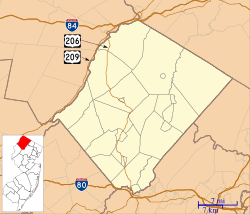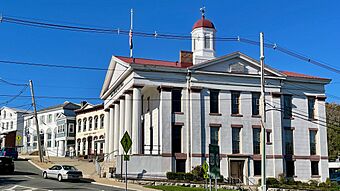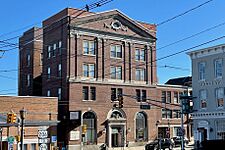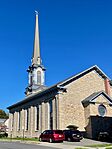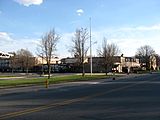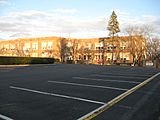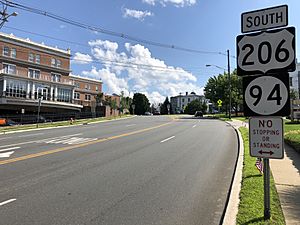Newton, New Jersey facts for kids
Quick facts for kids
Newton, New Jersey
|
||
|---|---|---|
|
Town
|
||
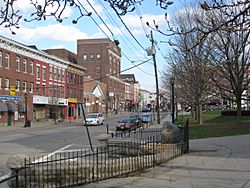
Spring Street Commercial District as seen from the Newton Town Green
|
||
|
||
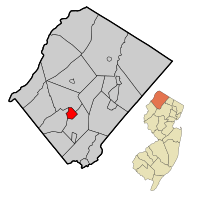
Location of Newton in Sussex County highlighted in red (left). Inset map: Location of Sussex County in New Jersey highlighted in orange (right).
|
||
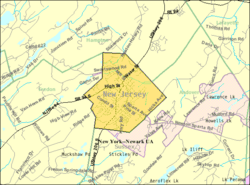
Census Bureau map of Newton, New Jersey
|
||
| Country | ||
| State | ||
| County | Sussex | |
| Incorporated | April 11, 1864 | |
| Government | ||
| • Type | Faulkner Act (council–manager) | |
| • Body | Town Council | |
| Area | ||
| • Total | 3.38 sq mi (8.76 km2) | |
| • Land | 3.36 sq mi (8.70 km2) | |
| • Water | 0.02 sq mi (0.06 km2) 0.65% | |
| Area rank | 317th of 565 in state 18th of 24 in county |
|
| Elevation | 663 ft (202 m) | |
| Population
(2020)
|
||
| • Total | 8,374 | |
| • Estimate
(2023)
|
8,240 | |
| • Rank | 283rd of 565 in state 5th of 24 in county |
|
| • Density | 2,492.3/sq mi (962.3/km2) | |
| • Density rank | 252nd of 565 in state 3rd of 24 in county |
|
| Time zone | UTC−05:00 (Eastern (EST)) | |
| • Summer (DST) | UTC−04:00 (Eastern (EDT)) | |
| ZIP Code |
07860
|
|
| Area code(s) | 973 exchanges: 300, 383, 579, 940 | |
| FIPS code | 3403751930 | |
| GNIS feature ID | 0885322 | |
Newton, officially called the Town of Newton, is a town in New Jersey, USA. It's the main town, or county seat, of Sussex County. Newton is about 60 miles (97 km) northwest of New York City.
In 2020, Newton had a population of 8,374 people. This was the highest number of people living there ever! The town is one of 15 towns in New Jersey that runs its government using a "council-manager" system. This means elected officials (the council) set policies, and a hired manager handles the day-to-day running of the town. Newton officially became a town on April 11, 1864.
Contents
History of Newton
Early Days in the 1700s
Newton is located near the start of the Paulins Kill river. This river is a 41.6-mile (67 km) long branch of the Delaware River. In 1715, a surveyor named Samuel Green mapped out a large area of land here for William Penn. This land was part of the last big purchase of Native American land in West Jersey. At that time, the area was home to the Munsee people, who were a group of Lenape Native Americans.
The first European settler recorded in Newton was Henry Hairlocker, who arrived before 1751. In 1751, a large area called the Newtown Precinct was created. Two years later, in 1753, Sussex County was formed. The name Newtown likely came from a colonial village in New York or because it was a "new town."
In 1762, a man named Jonathan Hampton chose the spot for a county courthouse and a town green. This spot was where a military road and a main north-south road (now New Jersey Route 94) met. The courthouse was finished in 1765, and the village around it became known as Sussex Court House. During the American Revolution, the courthouse was raided by a British loyalist.
In 1797, the village's post office was renamed Newtown. Later, in 1825, the spelling changed to Newton. On April 11, 1864, Newton Township was divided. This created the incorporated town of Newton and two rural townships, Hampton and Andover.
Newton's Historic District
The Newton Town Plot Historic District is a special area in Newton. It covers 17 acres (6.9 ha) along several streets like Church, High, Main, Moran, and Spring Streets, and Park Place. This district was added to the National Register of Historic Places in 1992. It's important for its architecture, businesses, town planning, and political history from 1762 to 1941.
The district includes 51 historic buildings and sites. Among them are the Sussex County Courthouse and the Hill Memorial. The Sussex and Merchants National Bank, built in 1927, shows off the Georgian Revival style. The Old Newton Burial Ground, started in 1762, is also part of this district. Its entrance gates have a cool design of Father Time.
-
Old Newton Burial Ground entrance gates
Geography and Climate
Newton's Location and Land Features
Newton is in the Kittatinny Valley, which is part of the huge Great Appalachian Valley. This valley is a 1,200-mile-long (1,900 km) chain of lowlands stretching from Quebec to Alabama. It's the eastern edge of the Ridge and Valley Appalachians region. This area has long, even ridges and continuous valleys that run parallel from southwest to northeast.
These land features were formed about 300–400 million years ago. This was during a time of great pressure and rock movement that created the Appalachian Mountains. The land here is mostly made of sedimentary rock.
Newton's land drains into two river systems: the Paulins Kill and the Pequest River. Both of these rivers flow into the Delaware River. These river areas are separated by slate ridges. People used to quarry, or dig out, slate from these ridges for roofs and other uses.
Weather and Climate in Newton
Newton is in the higher parts of northwestern New Jersey's Appalachian mountains. This means it has a cooler humid continental climate. This climate has a lot of rain or snow in all seasons. At least four months of the year have an average temperature above 50°F (10°C). This is different from most of New Jersey, which has a warmer climate.
During winter, Newton and Sussex County can get "nor'easters." These are big storm systems that can cause blizzards or flooding. Hurricanes, tropical storms, tornadoes, and earthquakes are rare here. The Kittatinny Valley, north of Newton, is known for its "Sussex County Snow Belt." This area gets about 40 to 50 inches (100 to 130 cm) of snow each year. This is more snow than other parts of Northern New Jersey. This happens because the Kittatinny Ridge makes the air rise, which increases humidity and snowfall.
In Newton, January's average temperature is about 17°F (-8°C), and July's is about 84°F (29°C). The average monthly rainfall ranges from 2.86 inches (7.3 cm) in February to 4.76 inches (12.1 cm) in June. Newton gets sunshine about 62% of the time in summer and 48% in winter. The wind usually blows from the southwest.
The lowest temperature ever recorded in Newton was −26°F (−32°C) on January 21, 1994. The highest was 104°F (40°C) on September 3, 1953. The most snow in one day was 24 inches (61 cm) on January 8, 1996. The most rain in one day was 6.70 inches (17.0 cm) on August 19, 1955.
People of Newton (Demographics)
| Historical population | |||
|---|---|---|---|
| Census | Pop. | %± | |
| 1860 | 1,824 | — | |
| 1870 | 2,403 | 31.7% | |
| 1880 | 2,513 | 4.6% | |
| 1890 | 3,003 | 19.5% | |
| 1900 | 4,376 | 45.7% | |
| 1910 | 4,467 | 2.1% | |
| 1920 | 4,125 | −7.7% | |
| 1930 | 5,401 | 30.9% | |
| 1940 | 5,533 | 2.4% | |
| 1950 | 5,781 | 4.5% | |
| 1960 | 6,563 | 13.5% | |
| 1970 | 7,297 | 11.2% | |
| 1980 | 7,748 | 6.2% | |
| 1990 | 7,521 | −2.9% | |
| 2000 | 8,244 | 9.6% | |
| 2010 | 7,997 | −3.0% | |
| 2020 | 8,374 | 4.7% | |
| 2023 (est.) | 8,240 | 3.0% | |
| Population sources: 1860 1870–1920 1870 1880–1890 1890–1910 1910–1930 1940–2000 2000 2010 2020 |
|||
Newton's Population in 2010
The 2010 United States census counted 7,997 people living in Newton. There were 3,170 households, and 1,842 families. The town had about 2,542 people per square mile (981/km²).
Most people in Newton were White (85.04%). There were also Black or African American (4.88%), Native American (0.49%), Asian (2.98%), and Pacific Islander (0.05%) residents. About 4.34% were from other races, and 2.23% were from two or more races. People of Hispanic or Latino background made up 12.34% of the population.
About 27.2% of households had children under 18. About 40.1% were married couples. The average household had 2.34 people, and the average family had 3.06 people.
About 21.2% of the population was under 18. About 18.5% were 65 or older. The average age in Newton was 41.9 years.
Arts and Culture in Newton
Museums, Galleries, and Libraries
Newton is home to the Sussex County Historical Society's Hill Memorial Museum. This is the oldest museum building in New Jersey that has been open continuously. The society, started in 1904, has old documents and displays about the region's history. You can see things from Mastodon bones to Native American tools and items from the Revolutionary War and World War II.
Other places to visit include:
- The Newton Fire Museum on Spring Street.
- The Sussex County Arts & Heritage Council, which has a gallery on Spring Street.
- The Dennis Library, which is part of the Sussex County Library System.
Performing Arts
The Newton Theatre used to be a movie theater. Now, it's a performing arts center with 605 seats. It was built in 1924.
Drama Geek Studios is a local theater group in Newton. They offer classes, workshops, and shows for people of all ages in Sussex County.
Places of Worship
Newton has many different churches and one Jewish synagogue:
- Christ Church, an Episcopal church founded in 1769.
- First Presbyterian Church of Newton, founded in 1786.
- The First United Methodist Church.
- Covenant Reformed Church.
- First Baptist Church of Newton, which moved to Newton in 1810.
- St. Joseph's Roman Catholic Church.
- Temple B'Nai Shalom, a Jewish synagogue.
- Christ Community Church of the Christian Missionary Alliance.
Sports in Newton
Skylands Park is a baseball stadium in nearby Frankford Township. It's the home field for the Sussex County Miners. They are a professional baseball team that plays in the Frontier League.
Parks and Recreation
Newton has several parks for outdoor fun:
- Memory Park: This park was created in 1928 with 10 acres (4.0 ha) of land donated by Newman E. Drake.
- Pine Street Park: A smaller park with a playground that hosts youth soccer games.
- Newton Square: A green area in the center of town. It's owned by Sussex County and can be used for events.
Education in Newton
Schools for Kids and Teens
The Newton Public School District serves students from kindergarten through 12th grade. High school students from Andover Borough, Andover Township, and Green Township also attend Newton High School. In the 2021–22 school year, the district had 1,586 students and 137 teachers. This means there were about 11.6 students for every teacher.
The schools in the district are:
- Merriam Avenue School (PreK-4)
- Halsted Middle School (5-8)
- Newton High School (9-12)
Saint Joseph's Regional School was a private Catholic school in Newton. It taught students from pre-kindergarten to seventh grade. The school closed in June 2016. Its students merged with other schools to form Reverend George Brown School in Sparta.
College Education
Sussex County Community College (SCCC) is a two-year public college in Newton. It has a 167-acre (68 ha) campus. The campus used to be a Catholic seminary called Don Bosco College. In 1989, Sussex County bought the property for SCCC.
SCCC started in 1981 and became fully accredited in 1993. It offers 40 associate degree programs. It also has 16 professional and health science certificate programs. Students can take classes on campus, online, or through distance learning. Many students from SCCC go on to finish their college education at a four-year university. The college also has programs for high school students and community education courses.
Transportation and Roads
Roads and Highways in Newton
As of 2010, Newton had 28.75 miles (46.27 km) of roads. The town maintained most of these roads.
Newton is located where several important roads meet. These include U.S. Route 206, New Jersey Route 94, and County Route 519. Interstate 80 is about 13 miles (21 km) south of Newton.
Public Transportation
The closest train station is Netcong, which is about 12 miles (19 km) south. Lakeland Bus Lines offers some bus service between Newton and Midtown Manhattan. Local bus service is provided by the Skylands Connect bus. This bus connects Newton to Sparta, Hamburg, and Sussex.
Aviation
Newton Airport was a public airport located 3 miles (4.8 km) south of the town center. The airport closed in 2013.
Media in Newton
Newspapers
Newton is home to the offices of the New Jersey Herald. This is the oldest newspaper in the state, founded in 1829.
Radio and Television
Newton has three radio stations:
- WNNJ on 103.7 FM, which plays rock music.
- WRSK-LP on 95.7 FM, from Sussex County Community College, playing oldies, big band, country, and polka music.
- WTOC (AM) on 1360 AM, which serves Newton in Spanish.
WMBC-TV is licensed to Newton, but its studios are in West Caldwell, New Jersey.
Famous People from Newton
Many interesting people have been born in or lived in Newton:
- Janeane Garofalo (born 1964), a well-known actress and comedian.
- John W. Griggs (1849–1927), who was the 27th Governor of New Jersey and later served as the United States Attorney General.
- Ardolph L. Kline (1858–1930), who represented Brooklyn in the U.S. House of Representatives and was acting Mayor of New York City.
- Leonard LaRue (1914–2001), a ship captain famous for a huge rescue operation in human history.
- Andrew Napolitano (born 1950), a former judge and TV analyst.
- Rodman M. Price (1816–1894), who was the 17th Governor of New Jersey.
- Jenny Owen Youngs (born 1981), a singer-songwriter.
Places to See in Newton
- Newton Cemetery
- Newton Town Green
- Old Newton Burial Ground: A historic cemetery that was the main burial place for a century after it started in 1762.
- Spring Street
- Sussex County Courthouse: The original courthouse was built in 1765. It burned down in 1847 and was rebuilt in 1848.
- Sussex County Community College
- Horton Mansion on the SCCC campus
See also
 In Spanish: Newton (Nueva Jersey) para niños
In Spanish: Newton (Nueva Jersey) para niños



